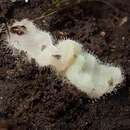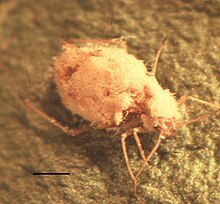en
names in breadcrumbs


The Entomophthorales are an order of fungi that were previously classified in the class Zygomycetes. A new subdivision, Entomophthoromycotina, in 2007, was circumscribed for them.[1]
Most species of the Entomophthorales are pathogens of insects. A few attack nematodes, mites, and tardigrades, and some (particularly species of the genus Conidiobolus) are free-living saprotrophs.
The name Entomophthorales is derived from the Ancient Greek for insect destroyer (entomo- = referring to insects, and phthor = "destruction"). Named after genus Entomophthora in 1856.[2]

Most species of the Entomophthorales produce ballistic asexual spores that are forcibly discharged. When not landing on a suitable host, these spores can germinate to make one of several alternate spore forms, including a smaller version of the original spore, or (in some species) an adhesive spore elevated on a very slender conidiophore called a capilliconidiophore.
Debates have centred on whether the Basidiobolaceae should be included in the Entomophthorales, or raised to ordinal status. Molecular systematics approaches so far give an ambiguous answer. Some analyses suggest the Basidiobolaceae are more closely related to certain chytrid fungi than to the Entomophthorales.[4] and place it within the Chytridiales order.[5] Others find weak support to maintain them in the Entomophthorales.[6] Morphological characters can be found to support either hypothesis.
The Entomophthorales are an order of fungi that were previously classified in the class Zygomycetes. A new subdivision, Entomophthoromycotina, in 2007, was circumscribed for them.
Most species of the Entomophthorales are pathogens of insects. A few attack nematodes, mites, and tardigrades, and some (particularly species of the genus Conidiobolus) are free-living saprotrophs.
The name Entomophthorales is derived from the Ancient Greek for insect destroyer (entomo- = referring to insects, and phthor = "destruction"). Named after genus Entomophthora in 1856.
 Green peach aphid, Myzus persicae, killed by the fungus Pandora neoaphidis (Zygomycota: Entomophthorales) Scale bar = 0.3 mm.
Green peach aphid, Myzus persicae, killed by the fungus Pandora neoaphidis (Zygomycota: Entomophthorales) Scale bar = 0.3 mm.